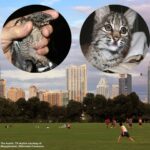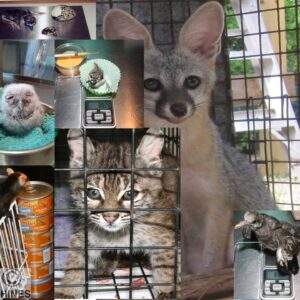Should I Become A Licensed Wildlife Rehabilitator? Is It The Right Thing For Me?
Ron Hines DVM PhD
 Dr. Hines’ Other Wildlife Rehab Articles
Dr. Hines’ Other Wildlife Rehab Articles
I have been caring for injured and orphaned wildlife since before you were born. It began when I was 9 years old and Virginia Moe who lived in the Victorian mansion pictured above gave me a baby Chicago street pigeon to care for. She had turned the old mansion, owned by the Cook County Forrest Preserve, into one of the first wildlife rehabilitation centers in America. Ms. Moe must have thought I had some potential because the next year she asked me to work for her after school and summers. Six years before that she had written the Animal Inn, the book pictured above. My reward was that we had agreed that when I wasn’t doing my assigned chores I could sit on the office floor next to her, read her many wildlife and veterinary books and learn from her years of experience. So I fed the birds. I fed the raccoons and opossums. I fed foxes in pens, snakes in terrariums and tortoises that wandered around on the hardwood floors. I tended to the meal worm farm and the mouse farms down in the basement and cut up horse meat. I caught fish for her shore birds in the Des Plaines River . Occasionally I would check on the welfare of her mother who lived on the very top floor. Virginia Moe was a lady of few words, but she was the most important influence in my life. She set me on a path from which I have never deviated.
How Can I Gain The Knowledge And Experience Necessary To Be A Wildlife Rehabilitator?
The only way I know of is to volunteer at a reputable wildlife rehabilitation center. Over the years I have learned that all wildlife rehabilitation centers are not created equal. I would avoid big organizations and those associated with zoos and other public attractions. Their underlying focus and motivations tend to be on the generation of positive public relations and the generation of revenue – both requiring hype, the glossing over of inconvenient facts, and insincerity. If they run bird shows, tours, possess performing animals or charge you for your education, their motivations are not the same as my motivation or yours.
It is the Center’s director whose philosophy establishes the organization’s rules. The actual wildlife rehabilitator volunteers can easily be overwhelmed with animals whose needs are beyond a volunteer’s capacity to deliver. Particularly when attempts at notoriety are high on the agenda in an attempt to generate money. That causes a lot of stress and turnover among the animal care staff. So look for a rehabilitation center with the lowest staff and volunteer turnover. Of course those are likely to have the fewest open slots. Compassion and disposition of the animals that arrive tends to decrease as the number of paid staff grows. Over the years I have found that individuals who focus on rehabilitating a single species usually do a better job, suffer less personal stress and burnout and gain greater personal satisfaction than those who attempt to deal with multiple species on a large scale. From my many years aiding wildlife and the many emails I receive, I venture a guess that only 10-15% of successful wildlife rehabilitators ever apply for state or federal rehabilitation licenses. They are good Samaritans who realized that compassion for wildlife requires no State or Federal license and that the possession of an official license does not guarantee compassion.
What Type Of Person Makes A Good Wildlife Rehabilitator?
You know yourself best. People with empathy for all animals make the best wildlife rehabilitators – even though they suffer the most when an animal cannot be saved. People with deep nurturing tendencies seem to have a green thumb when it comes to raising wildlife orphans. Considerably more of them are women than men. Unfortunately success rates with individual wildlife species is not distributed equally. Desire and good intentions does not always match results. Many people who relate well to wildlife in need of care are uncomfortable dealing with the public. They have a key roll in wildlife rehabilitation – just not in positions that require public interaction. Someone else needs to be assigned that chore.
Are There People Who Probably Should Not Be Wildlife Rehabilitators?
Yes.
Zoos and profit-based entities that exist primarily to entertain the public are not compassion driven. Universities and places of learning intent on gathering wildlife for research and scientific publications are not compassion driven. Self-centered and narcissistic individuals seeing themselves as animal “whisperers” and seeking notoriety are not compassion driven. For them, public image and the gathering of donations are paramount. People who anthropomorphize animals (“they are just furry little people like me”) do not make good wildlife rehabilitators.
How Much Of My Time Will Be Required?
Probably more than you anticipate. Wildlife that depend on humans for their care require constant attention. Tiny summertime songbird babies need to be fed every 15-30 minutes from dawn to dusk. Nursing infant mammals need their formula every few hours. Then there are the diet preparation and facility clean up chores. It can lead to one being quite tired by the time the blessed fall season rolls around. There will be many telephone calls – some from people wanting free animal pickup or ambulance services. Others with unrealistic expectations. Many of these folks believe that the government pays you for your service – like child foster care. The only way I know of to minimize your stress and increase your success is to resist taking in more animals than you are capable of lovingly caring for. That will always be a temptation that you will find difficult to resist. Becoming a member of a larger group that spreads the work load around is important too. Recognize your limits and wildlife rehabilitation’s heavy demands on you, your family and your friends. One of my best friends, who runs a large wildlife rehabilitation facility in Florida, has not taken a vacation with her husband in over 30 years.
When Will Be My Busiest Months?
Can I Afford To Do This?
I mentioned that a common misconception is that “the government” pays for what you will do. Or perhaps that the dog and cat charities you see soliciting donation on TV help you out. Perhaps they think that you are a person of means or that a rich philanthropist pays the rehabilitation expenses. You will soon discover that the bills add up. You will have to buy a lot of quality food for these animals. Being a veterinarian, my method in Florida was to vaccinate every pet owned by an employee of our local Sam’s Club in return for their surplus vegetables and fruit. I included the surrounding Walmart’s as well in exchange for their torn sacks of dog and cat chow. I derive great satisfaction from taking in “lost cause” wildlife injuries – the ones that are usually sent to the iso chamber. So I beg most of my medical supplies from local hospitals. Here on the Texas border with my proximity to Mexico I find those hospital donations much harder to get. Building quality cages and pens cost lots of money. The Home Depot’s , Team Depot built a few large cages for me. But I constructed and paid for the majority of them myself. Revenue from the ads you see running on this site help as well. Every click on them sends me a few more cents for supplies. One rehabilitator I know ran a silk screen printing business to help pay rehab expenses. One near San Antonio had a paper route. In Texas and Florida you are not permitted to charge a fee for caring for the wildlife that are brought to you. Although I never have, you are allowed to solicit donations from people who bring you animals. I do accept donations when they are offered – which is rarely. If you don’t incorporate as a 501(c)(3) tax-exempt organization, you will also be responsible for paying taxes on those donations. If your home and property are deed restricted or if your zoning does not permit it, you may run afoul of various zoning and deed restrictions. I get around that by living next door to a low-income trailer park. I don’t complain about their chickens, loose cats and late night beer parties and they don’t complain about my cages and their temporary wildlife residents. I do not know where your legal liability for accidents begins. When I ran a dog and cat clinic at our local Petco to generate money for wildlife care, my liability began when the clients entered the main shopping center parking lot. If they tripped on a leash, if their dog bit them, if their cat scratched them or if their pet was off-leash/out of carrier and ran away – legally it was considered my fault. At that time Petco made me carry my own 1 million dollars liability insurance.
What Is The Most Difficult Part Of Being A Wildlife Rehabilitator?
For most of us, it is dealing with euthanasia and wildlife death. It is a rarely-mentioned fact that less than half of all adult and injured wildlife ever reach a point where they can live free again on their own in the wild. At one state-of-the-arts and well-funded rehabilitation center in New Jersey that made their records public (very very few do), only 41% of adult animals that were admitted reached a status where they could be released. Fifty nine percent either died during treatment or had to be euthanized. Of those brought in extremely young (neonates) 25% survived. The best hope is always for juvenile animals not quite yet adults = animal teenagers. Seventy four percent of those were successfully released.
A few showy non-releasable animals might get state permits as “ambassador” animals to be taken to schools, meets, educational events and solicitations for donations. But those are a drop in a very large bucket. As a child, when I was an assistant to Virginia Moe at the wildlife rehab center in Chicago, the only time she lost her temper with me was when a box full of fox squirrels whose eyes had not yet opened were brought to us in mid-summer. She told me to take them down to the basement and chloroform them. When I protested that I could raise them myself she shouted at me, “How dare you! A species that boil a calf in its mother’s milk tell me what to do!” I could see that the fact that more animals came in than she could possibly care for pained her deeply. It troubles me to this very day. One can avoid speaking about it. One can deny it as many do. One can harden one’s heart to it. But it is a grim fact of life that is generally hidden from the public by all concerned. Yes, the glowing descriptions of wildlife salvation that you see on Litton Entertainment, Disney Animal Kingdom, SeaWorld and the PR videos produced by State Wildlife Agencies and rehab centers do occasionally happen. But their’s is a storybook world hiding a grimmer reality. When it comes to animal death and euthanasia, state wildlife commissions will walk away and leave it to you as a rehabers to struggle with. As a new wildlife rehabilitator, you will stay up late nights caring for an animal and hoping for the best. You will give it medications and tender care. You will talk to it. You will pray for it. You will become attached to it and its death – assisted or natural – will traumatize you just like it does me. Are you capable of going through that over and over again? When you euthanize badly injured animals you might tell yourself that at least you spared the animal prolonged suffering. That is true. It is much harder for me to kill an animal that still had the potential for assisted living – but in the United States most if not all State and Federal Wildlife officials will give you a time limit after which you ( not they) must destroy it. Animal euthanasia is the most common cause of burnout among those who staff wildlife rehabilitation centers in North America. The most commonly used method is an overdose of isoflurane gas. Limit your exposure to the fumes. I personally use other methods because I hold a DEA narcotics license. I overdose them with narcotics sold to minimize pain. Your vet can do that, but it takes an emotional toll on everyone involved.
Will I Have To Pass An Exam And Comply With My State’s Laws?
Yes
Some states require that you pass an examination and some do not. Some require that you apprentice under a licensed state wildlife rehabilitator and some do not. Some require that you take periodic continuing education and some do not. I know of none where a high school diploma is required. My permits, beginning in 1975, have been from Texas Parks & Wildlife and the Florida Fish And Wildlife Conservation Commission (FWC). In 2021, TPW went from a common sense procedure in issuing wildlife rehabilitation permits to extremely strict, detailed and time consuming quarterly reports requiring geo-coordinates of each animal’s found and release location, numerically coding of all animals, approved continuing education and membership in an approved national wildlife rehabilitators association (think NWRA) – all in a disguised attempt to reduce the number of small independent-minded licensed wildlife rehabilitators. TPW’s focus has always been strictly on venison and shoulder mounts, not animal welfare – so they wholeheartedly embraces that approach. Needless to say, over 95% of the Texas licensed wildlife rehabilitators queried thought that was an entirely unnecessary burden to impose on us. Recent emails from TPW indicate that they might be revising their policies in light of the disaster for animals these changes have produced. Florida’s FWC still remains considerably more wildlife rehabiltator friendly – for now.
Your regional office of the US Fish & Wildlife Service requires similar information when the animal is a migratory bird – and they define most any native American bird as migratory. Meeting bureaucracy’s current demands is a heavy, time-consuming burden for the people who rehabilitate orphan and injured wildlife today. I must actually pay the USFWS for my permit to help injured animals – not the other way around. In my experience, these reports are seldom (if ever) read by those who demand them. Most officials that regulate wildlife in the United States see animals as a commodity to be managed – like water and oil resources or band wavelength. I have yet to meet one with true compassion for animals and none that ever managed a wildlife rehabilitation center. My experience over many years is that the Texas Parks & Wildlife Commission focuses on venison and shoulder mounts. They give lip service to what we rehabilitators do – but nothing more. You can read more about that here.
Is That The Same Throughout The World?
No. In 2021 in England for example, no special permit is required to aid sick, orphaned or injured wildlife. Great Britain only requires the humane treatment of animals of any kind. In Finland, anyone is allowed to care for injured and orphaned wild animals as long as their goal is eventual release. In Germany any animal rescue group or veterinarian can care for injured wildlife. In Ireland, no permit is required, but each animal needs to be registered with the Department of Environment. Only a federal permit is required in Belgium and Holland, but in Canada, both provincial and federal permits are required. In Estonia wildlife rehabilitation is illegal as of this 2021 writing.
If You Were Starting Your Life Over Would You Become A Wildlife Rehabilitator Again?
Yes




